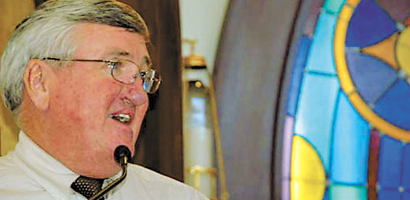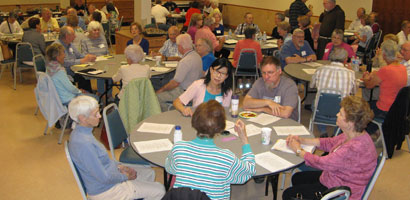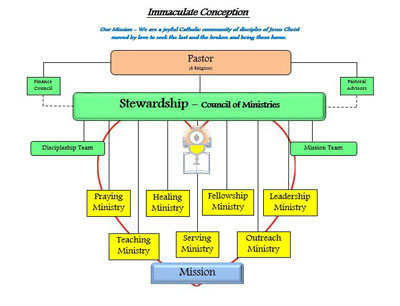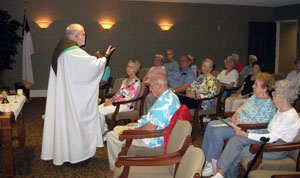 CHARLOTTE — The former principal of Charlotte Catholic High School who pleaded guilty to one felony count of misappropriating more than $160,000 from the Charlotte Catholic High School Foundation and, also, certain school accounts has been sentenced to 24 months probation and must spend three months in a halfway house. He will also be required to make restitution.
CHARLOTTE — The former principal of Charlotte Catholic High School who pleaded guilty to one felony count of misappropriating more than $160,000 from the Charlotte Catholic High School Foundation and, also, certain school accounts has been sentenced to 24 months probation and must spend three months in a halfway house. He will also be required to make restitution.
Gerald Healy appeared April 19 before U.S. Chief Judge Frank D. Whitney. During a sentencing hearing at the federal courthouse in Charlotte that lasted less than 60 minutes, Healy was sentenced for mishandling funds from the Charlotte Catholic High School Foundation a non-profit that operates separately from the school, using checks drawn out of a Bank of America account from April 2007 to February 2014 to pay for personal expenses.
According to the U.S. attorney's charges, Healy "misappropriated both the School's and the Foundation's money for his personal use ... by writing or having his assistant write checks to him. On at least four occasions, Healy forged the name of his assistant on Foundation checks made payable to himself."
Healy resigned as principal on May 20, 2014, following a separate audit of school finances by the Diocese of Charlotte that uncovered unspecified "questionable disbursements" from high school accounts.
Specifics were not disclosed at the time, but a June 17, 2014, letter from the Charlotte Catholic High School Foundation, an independent fundraising organization that provides scholarships and supplies for the high school, said Healy had been "making personal use of funds held by the foundation."
Healy's attorneys had insisted that the foundation had no written procedures for use of the funds in the account, and that the money had been used to help members of the Charlotte Catholic High School community.
In the plea hearing, Assistant U.S. Attorney Kevin Zolot said Healy "has been completely cooperative" throughout the federal investigation that followed the audit of the funds. In the sentencing hearing Zolot explained the government's position on recommending probation was due to the consideration that Healy had "spent a lifetime of doing good things for students" and "the amount of impact he's had on people's lives can't be quantified."
Healy could have faced up to 10 years in prison and a $250,000 fine.
Healy read a statement to the court before the sentence was handed down, saying, "I stand before you as a man who let people down... I am truly sorry for letting people down... I hope to regain the trust of the community... Charlotte Catholic High School is and always will be special to me. I can't begin to repay them for all the good they have done for me. I am truly sorry."
The Charlotte Catholic High School Foundation is an independent organization which is not managed, administered or controlled by the diocese. The investigation of the foundation's finances had no impact on the school's education program or tuition accounts, noted David Hains, diocesan director of communication.
Kurt Telford, principal at Charlotte Catholic High School, sent out a communication to the parents of students, saying, "This morning Mr. Healy was sentenced in federal court. I ask that you continue to pray for him and his family. Charlotte Catholic continues its focus on a well-rounded faith based education with an emphasis on academic excellence and this focus is evidenced in many ways."
Telford cited the school's recent accomplishments including two Division 4A State Championships for varsity men's football and basketball.
"I thank each one of you for your part in the success of Charlotte Catholic. As a school community we can be proud of our many accomplishments," he told the school community.
Charlotte Catholic was founded in 1955.
— Patricia L. Guilfoyle, editor. SueAnn Howell, senior reporter, contributed to this article.
 HENDERSONVILLE — What is the mission of a parish?
HENDERSONVILLE — What is the mission of a parish?
That's the question Capuchin Franciscan Father Martin Schratz posed to his parish council at Immaculate Conception Church a few years ago. The Hendersonville parish had a mission statement, of course, printed in its weekly bulletin, but no one could remember what it was.
That realization served as a wake-up call for the parish lay leaders, who under the pastor's direction formed a nine-member mission team and began a period of prayer and discernment, asking themselves: What is the purpose of our parish? Where are we going? What are we to do when we get there?
Over the course of nine months, answers to their questions slowly came to light through what they believe was the working of the Holy Spirit. The result is a new parish mission: "We are a joyful Catholic community of disciples of Jesus Christ, moved by love, to seek the lost and the broken and bring them home."
To better clarify the mission, the team broke it down into seven phrases, which come together to provide a single mission. Their prayer is that it "has the ability to touch, inspire and move God's people. That it speaks to each of our hearts. That it unifies us without limiting our movement. That it provides focus while not constraining. And that it calls us to respond to the promptings of the Spirit – uniquely as individuals and communally as the Body of Christ."
 "It's not a mission statement," explains Bob Lange, longtime parishioner and the mission team leader. "A mission statement feels passive. This is a mission! Mission is action. You could hear a pin drop in the room afterwards when we presented it to our parish council, there were a lot of tears. It's a very provocative mission. Seeking the lost and the broken and bringing them home is something we don't talk a lot about as Christians."
"It's not a mission statement," explains Bob Lange, longtime parishioner and the mission team leader. "A mission statement feels passive. This is a mission! Mission is action. You could hear a pin drop in the room afterwards when we presented it to our parish council, there were a lot of tears. It's a very provocative mission. Seeking the lost and the broken and bringing them home is something we don't talk a lot about as Christians."
He noted that we all have this hidden brokenness and a hidden feeling of being lost. It applies to everyone. Bringing people "home" means bringing them to the Heart of Jesus to allow His healing Presence to change their lives.
Parishioners then asked themselves: do we have a parish capable of performing this mission? The answer was no. So parish leaders spent months discerning how the parish could live its new mission.
Said Lange, "We started with a blank sheet of paper, which is very freeing, but it's also a very scary thing because there is no roadmap. We spun our wheels for a while. We had to ask ourselves if we were going to design our parish around what Jesus did, how would we do it? We looked at how Jesus spent His days. What did He do? It was a basic approach, but that is when the blank sheet of paper wasn't blank anymore."
The work led the parish to reorganize its various ministries and groups established over the parish's 100-year history into seven core ministries that model Christ's mission: praying, teaching, serving, healing, outreach, fellowship and leadership.
"Those are the seven things Jesus occupied His time doing. We realized we didn't have to be clever, or cute, or corporate-minded about it. We didn't have to invent anything. We just had to do what He did. We developed and designed a parish that looks like Him," Lange said.
"We realized we're not just designing a parish, we are designing the Body of Christ," Lange said. "It just changed everything. We decided we're not doing things because it is organizationally necessary, we wanted to design the Body of Christ."
Adds Father Schratz, "From there a structure evolved with the finance council and a special pastor's advisory group, both of which work directly with the pastor."
"It was daunting to take this in another direction," Lange noted. "Some ministries were populated strongly and some didn't exist. What Catholic parish has a conscious leadership development ministry? Or a healing ministry? A considerable amount of what Jesus did was related to healing."
One particular mission of the parish, they strongly believed, was the shepherding of souls, because Christ is the Good Shepherd.
So the team created "shepherding groups" to guide and uplift the parish's ministries. These supporting groups were split into five areas: stewardship, discipleship, mission team, pastoral advisors and the finance council.
They also redefined "stewardship" as a focus on someone who is being entrusted with something from the Master.
"What's valuable is the precious lambs that have been entrusted to our parish: the people," said Lange. So everything at Immaculate Conception now revolves around doing what Jesus did and bringing souls closer to Him in the Body of Christ.

 The mission team has also selected patron saints to help guide and intercede for each of the 12 areas highlighted in their new mission: the seven core ministries and the five shepherding groups. For example, St. Faustina Kowalska is their patron of the praying ministry. St. Andrew, who led Peter to Jesus, is the patron of the leadership ministry. The Blessed Virgin Mary is the patron of the discipleship ministry. And St. Thérèse of Lisieux is the patron of their mission team.
The mission team has also selected patron saints to help guide and intercede for each of the 12 areas highlighted in their new mission: the seven core ministries and the five shepherding groups. For example, St. Faustina Kowalska is their patron of the praying ministry. St. Andrew, who led Peter to Jesus, is the patron of the leadership ministry. The Blessed Virgin Mary is the patron of the discipleship ministry. And St. Thérèse of Lisieux is the patron of their mission team.
Once everything was set up and shared with the entire parish, everyone recited the mission at Mass for a few months. The mission is now stated at all meetings and has become the focus of who they are as a parish.
Father Schratz says he also invited everyone involved in ministry, starting with the parish council, to read a book by Paulist Father Robert S. Rivers entitled "From Maintenance to Mission."
"Too often we just maintain our parishes. This book challenges us to be a parish with a mission.
"With this new mission and now with a new Holy Father and his thrust for evangelization, what better place to turn to then to the Gospels and the life of Jesus?" Father Schratz noted. "If we are following Jesus, let us look at His life and work and model our parish on His life."
— SueAnn Howell, Senior reporter. Photos provided by Bob Lange

